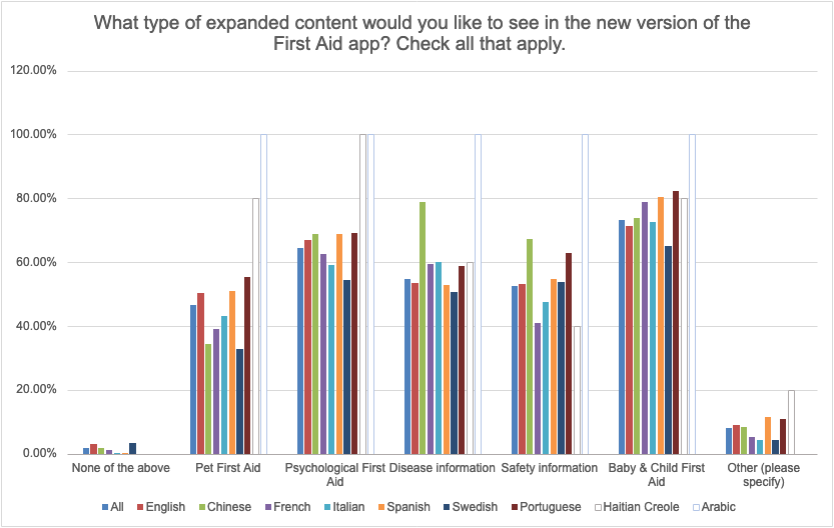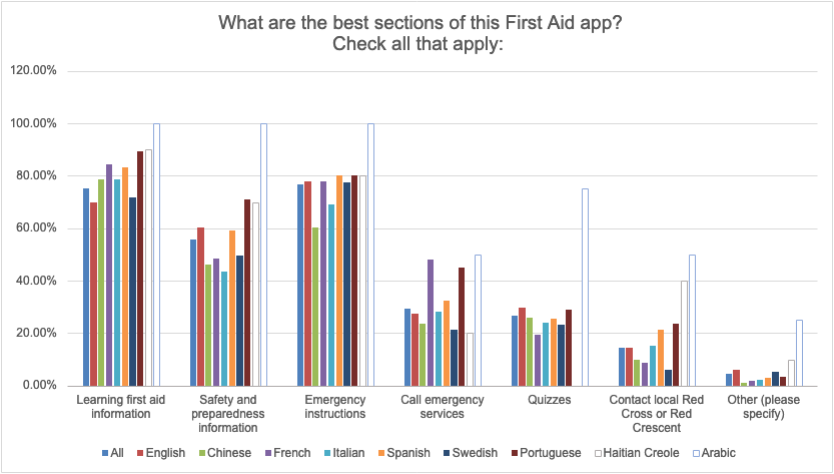Consider actively pushing out information to app users on topics of contemporary concern, like expanded content on environmental and social crises.
Address contemporary areas of concern
Increase the app's relevance for users
The app has the potential to be more relevant not only to individual users and skilled user groups, but also to specific regions / populations. Beyond customization for stages of training and individual learning styles, the app might better address regional issues.
The 2 key areas of broad concern that emerged from our research are environmental disasters and social crises.
“In France, there are big weather changes and effects, but we have less information about this.”
– Salomé Boucif, GFARC, Croix-Rouge française
Provide content on environmental crises
+ Environmental Crises: Due to catastrophic effects of climate change, First Aid is more widely recognized as a preventative measure and an act of response to increasingly common environmental crises. This was a common topic brought up by respondents in our study and many participants are looking for more content related to contemporary issues like survival skills, climate change and disaster response. Topics like forest fires and flooding were commonly mentioned as well by respondents.
“It would be great if we (program developers) got an alert if a lot of people were, for example, looking at asthma to inform social and other campaigns. This would enable us to be more responsive to emerging learning needs in different communities.”
– Joanna Muise, Canadian Red Cross
Be responsive in addressing contemporary social crises
+ Social Crises: Social crises are another significant area of concern that emerged from our research. Many participants are looking for much more content, resources, and advice when it comes to helping individuals in mental health crises, including those dealing with drug addictions and overdoses (especially related to opioid addiction).
These 2 areas of concern - and more - may require more regularly refreshed, fluid content maintenance and expanded templates to provide in-the-moment information and resources. A good example of this responsive approach can be seen in Duolingo's recently released Ukrainian Phrasebook that anticipates the need for aid workers and other international supporters who may need to communicate with Ukrainian refugees arriving in their countries.
To hear about how issues related to climate change have affected how a study participant in Turkey has approached First Aid, click on the video above.
Design Recommendations
Share timely content with app users based on search trends
Climate change and social crises
Develop a content strategy that includes information on climate change and social crises such as the opiod crisis and armed conflicts. App users told us that they make direct connections between this content and First Aid, and would benefit from clear explanations of how these pertain to their practice.
Expanded content areas
When asked what type of expanded content current app users would like to see in the new version of the First Aid app, survey respondents identified baby and child, psychological and disease information as the top categories across most language groups.
Pet First Aid and "more information on safety" were also things respondents said they would like to see in the new version of the app.

Chart showing the survey responses to the question, "What type of expanded content would you like to see in the new version of the First Aid app? Check all that apply."
Survey participants also proposed a number of additional content areas that are worth noting:
+ Common First Aid scenarios made available through a search function or a list of popular topics
+ First aid information in sign language and subtitled videos to enhance the app’s accessibility to a wider user group
+ First aid information for kids
+ Backcountry and survival tips
+ More quizzes, videos and images
+ Locations of nearby defibrillators
When asked what the “best sections" of the current First Aid app were, most respondents answered: emergency instructions, learning First Aid information, and safety and preparedness information (in that order).

Chart showing the survey responses to the question, "What are the best sections of the First Aid app? Check all that apply."
It should be noted that the preference for "learning First Aid" may have been a result of higher numbers of First Aid instructors/trainers responding to the survey.
In addition, the popularity of the “call emergency services” section amongst Swiss respondents may be related to the fact that the Swiss First Aid app may include call buttons for search and rescue services. The content in this section is unique to the Swiss version of the app.
Language and translation
Predominance of English
The dominance of English causes it to be seen as authoritative and neutral at the same time which causes certain problems, like excluding local nuances and ways of doing things that get quite literally lost in translation.
Alphabetization
Differences in alphabetization can cause content to be deprioritized when it is sent to the bottom of a list, once it is translated into another language.
English first
A number of research participants talked about how they consider the English version of First Aid material to be most authoritative. Beyond cultural bias, the superior quality of the English content is related at times to the fact that non-English versions of content are translated from English.
Additionally, most "international" content is usually created in or translated into English first, so there is an inherent delay in providing versions of content in other languages.
Design
Recommendations
Develop content in local languages first
We recommend opening a pathway for national societies to develop content in their native languages first, so that it can then be translated into English for the benefit of users in other countries.
Intentional list design
Alphabetization implies hierarchy
Long alphabetized lists are sometimes responsible for users overlooking important content, when they need to scroll to the end of a list to find it.
“People who want to download the West African app at times download the wrong version because they don’t realize that they have to scroll down to the bottom of the list to find the most appropriate version of the app.”
– Auwal Muhammad, Nigerian Red Cross
Lists can restrict users' navigational choices
At times, the prioritization of content imposed by the list format is based on assumptions that force the user to take a specific path through the content, which may not match the path that they would prefer to take.
Users are directed to "learn" first
Currently, First Aid app users are directed to "learn" content rather than to "emergency" content. We recommend that information architecture and hierarchy is informed by feedback provided by app users in this study, as the preference for educational over emergency content may only apply to a sub-group of users.
Consider non-linear formats
Consider representing lists in a circular or cycling orientation, to reduce the hierarchy imposed by alphabetization.
Design for flexible use
Give users an opportunity to decide for themselves which sections they would like to access first.
Dispelling First Aid myths
A number of participants talked about the importance of dispelling myths about First Aid that sometimes stem from entrenched beliefs about the efficacy of home remedies and amplified by social and mass media. This is not to discount the value of traditional medicine, which was an area of expanded content that app users were interested in incorporating into the First Aid app.
If learners are presented with scenarios, they can better understand limitations and barriers imposed by commonly held myths and misinformation e.g. holding one's head back when one has a nose bleed, applying alcohol to a wound, or rubbing butter on a burn.
“There are a lot of myths about First Aid and the primary goal of First Aid training is to dispel them. [The ones spread on] social media… are a big problem for First Aid instructors… They may say [to do] something, but the group will say, but we saw such and such online/on TV/in the movies [and be afraid of or resistant to following the instructor’s directions].”
– Matías Pérez Duclos, Cruz Roja Argentina (Argentinian Red Cross)
Consider non-linear formats
Provide opportunities for app users to experience situations in which the utility of the accepted First Aid process over the First Aid myth is obvious.